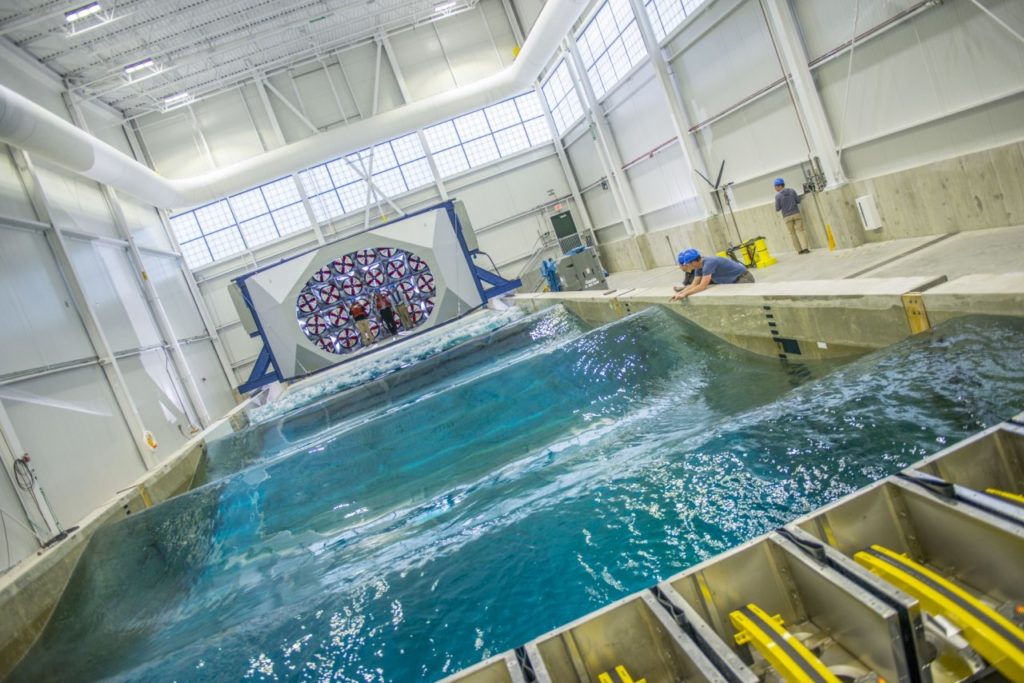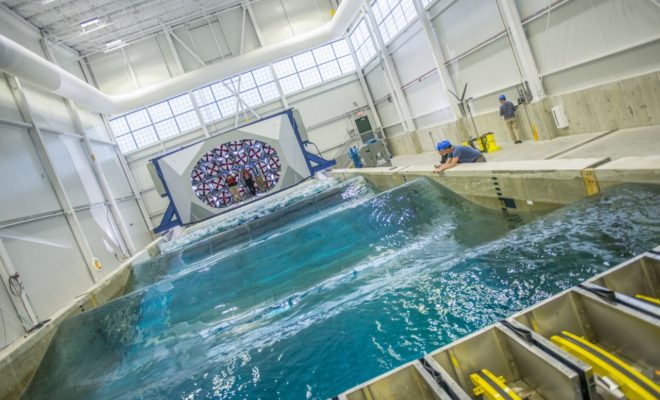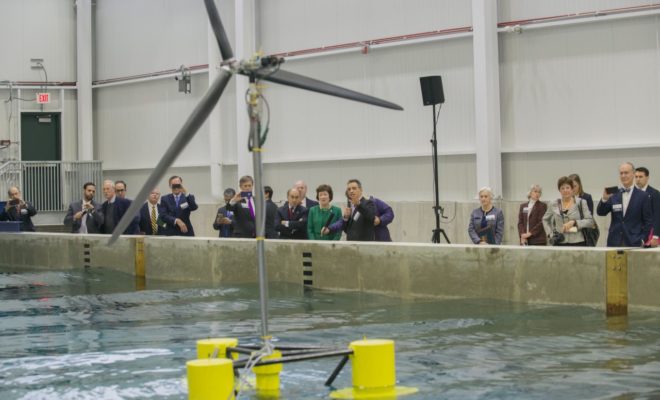FORCES TO RECKON WITH: In a first, simulator generates both wind and waves to test structural strength against ocean forces
Posted
Last Updated
By Laurie Schreiber
SHIPS, OIL RIGS, OFFSHORE WIND TURBINES,
BRIDGES, SEA WALLS: whether on the high seas
or close to home, they are all subjected to elemental
forces. They exist in an environment that tests human
ingenuity on the calmest day as well as during nature’s battering
fury.
The dilemma is how to test designs for these structures
ahead of time. A multi-million-dollar facility at the University
of Maine’s Advanced Structures and Composites
Center in Orono, Maine, is a part of the solution. Its
founders say it is the world’s first combined wind-and-wave
simulator.
“Around the world, there are wind tunnels and wave
basins built for a variety of purposes. But no one, before this,
has put them together,” says UMaine Composites Center
founding director Habib Dagher, who led the effort to construct
the facility, called the Harold Alfond W2 Ocean Engineering
Laboratory.
The Olympic-pool-size basin is capable of simulating
any wind and wave scenario imaginable—hurricane-force
winds, wave heights of 120 to 130 feet, confused seas, shifting
wind direction—at a scale of 1 to 50.
“If you want to test a 300-foot-long ship, divide that by
50 and build a 6-foot model,” says Dagher. “If you want to
use that ship in 300 feet of water, divide 300 feet by 50, and
the basin depth needs to be a 6-foot depth.”
W2 is a 100-foot by 30-foot basin equipped with a
multi-paddle wave maker at one end, capable of creating
waves of varying frequency. The system also incorporates
a rotatable open-jet wind tunnel, a concrete floor that moves up and down to model a variety of depths up to 750
feet, and a tow carriage.
The need for W2 became apparent in 2008, when the
lab was commissioned to test a floating offshore wind turbine
for durability in wind and waves. Dagher and his team
searched the world for a combined facility, with no results.
For that contract, they designed a limited wind machine at
a marine facility in Europe. When they subsequently surveyed
more than 50 companies across the nation in various
industries—including shipbuilding, ocean energy, offshore
wind tidal energy, oil and gas, aquaculture, and civil infrastructure—
they realized there was great potential for a purpose-
built facility.
The idea was to build a dual facility, with W2 adjacent to
a manufacturing plant, the Harold Alfond Advanced Manufacturing Laboratory, that could build prototype test models in as little as a week’s time using advanced materials and techniques, including 3D printing and thermoplastic-formation.
(Thermoplastics are polymers that become moldable
above a certain temperature.)
“Let’s say you have a ship and you’re interested to see
how well the ship will do in a variety of ocean environments,”
says Dagher. “Having the ability to model both the
wind and wave environment simultaneously is unique.”
Building the W2 facility required the development of
new engineering and construction techniques. For example,
the basin incorporates a beach at one end that “kills”
the waves when they hit its perforated structure.
“When you’re applying waves in a basin, the waves travel
from one end to the other end. You don’t want the wave to
reflect back, or that will affect the accuracy of your results,”
Dagher says. “You want the wave to go, but never come
back. We spent a lot of time devising a beach design that
allows us to attenuate the wave within a short distance.”
Likewise, figuring out how to make the basin floor
move was no simple feat. Dagher and his team learned
about a steel floor that moved via a hydraulic system, but
at $1 million it was too expensive. Then they designed and
built the nation’s first floating wind turbine, using floating
and lightweight concrete technology, and realized the same
technology could be used for the W2 floor.
“It priced out at $150,000—and it’s a unique construction,”
Dagher says.
Construction of the wind wall also required considerable
invention. Whereas most wind tunnels provide constant
wind speed, W2’s rotating wind wall—comprising
multiple jets set in a compartmentalized wall at one end of
the basin—accurately models the increase in wind speed
that occurs with greater elevation, and it provides for shifts
in wind direction.
“When you provide a wind regime over a wave basin,
the wind regime has to follow strict requirements in terms
of accuracy and turbulence of the wind,” Dagher says.
“When you design something that’s bigger than a dump
truck that rotates, that’s significant. There’s no off-the-shelf
design out there that rotates to increase wind speed.”
Boatbuilders are among those who expressed great
interest in W2, Dagher says.
“A boatbuilder can test a new design in terms of its seakeeping
capability. Or, say you have a new design for a sailboat
for the America’s Cup. You can build a model and subject
it to a variety of wave and wind environments.” Overall,
he says, the facility has great potential for Maine. “Our
ocean-based economy is a big part of the overall economy.
This is a big deal for a state that relies on the ocean.” ■Excerpted from Boats of the Year 2016. Click here to read more stories from the latest edition.



